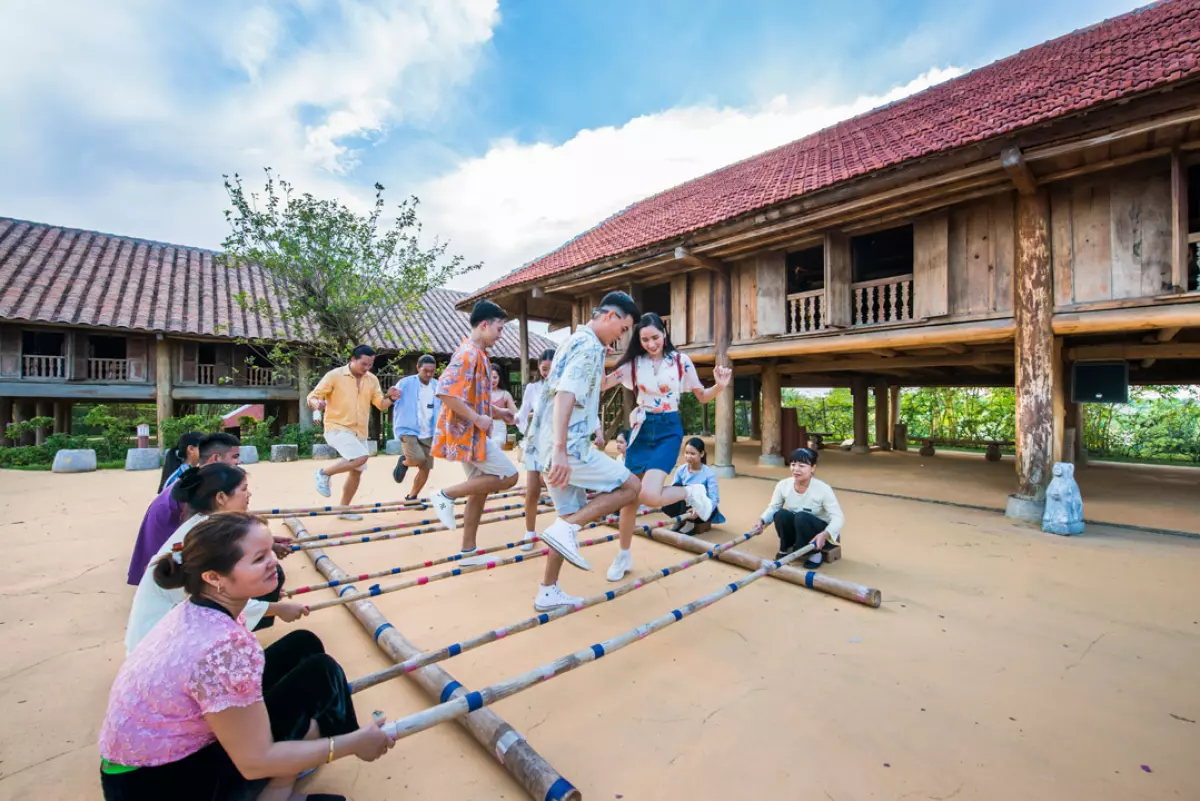 Image: VinWonders Nam Hoi An
Image: VinWonders Nam Hoi An
When it comes to Vietnamese houses, there is so much to discover and admire. These unique dwellings, scattered across the country, offer a fascinating glimpse into Vietnam's historical and cultural heritage. Join us on a journey to explore the top 10 Vietnamese houses with ancient architecture, and get ready to be captivated by their charm.
A Glance at Vietnamese Houses and Their Features
Features of Vietnamese Houses Over the Three Regions
When visiting a new place, exploring houses is not only an opportunity to witness stunning architecture but also to gain insights into the local lifestyle. Vietnamese houses, shaped by various factors such as geography, climate, and local customs, exhibit distinctive architectural identities across the three regions.
Northern Vietnam
 Picture: A Northern Vietnamese House
Picture: A Northern Vietnamese House
In Northern Vietnam, you will find houses with rustic appearances. These single-story structures are constructed using natural materials like bamboo, thatch, straw, wood, and bricks. Northern Vietnamese houses typically have three to five compartments, with the middle one being the largest. The roofs feature steep slopes to facilitate rainwater drainage and prevent waterlogging during heavy rain. Traditional customs dictate that special occasions are celebrated in the front yard of these houses.
Central Vietnam
 Picture: A Central Vietnamese House
Picture: A Central Vietnamese House
Traditional houses in Central Vietnam boast a unique layout with interconnected sections and adjoining roofs. The upper part, called "nhà trên," is dedicated to ancestral altars, while the lower part, called "nhà dưới," serves as the living space. One of the most popular house styles in this region is "nhà kèo," which uses a system of truss beams as supporting pillars. Other notable types include "nhà nọc nứa" and "nhà rọi," featuring a central column directly supporting the roof.
Southern Vietnam
 Picture: A Southern Vietnamese House
Picture: A Southern Vietnamese House
In Southern Vietnam, the "nhà ba gian Nam Bộ" or three-compartment house is a prominent ancient architectural style. These houses are primarily built with ironwood and consist of interconnected compartments. The upper part, known as "nhà trên," is used for ancestral worship, while the lower part, "nhà dưới," serves as the living space. Another common sight in the Mekong Delta region is the "nhà bè" or Vietnamese houseboat. These floating houses, designed for daily activities like fishing and shopping, showcase the ingenuity of Vietnamese architecture.
Types of Traditional Vietnamese Houses
Houses with Bamboo Walls and Thatched Roofs
 Picture: A Traditional Vietnamese Bamboo House
Picture: A Traditional Vietnamese Bamboo House
Commonly found in rural areas, traditional Vietnamese houses with bamboo walls and thatched roofs exemplify the harmonious relationship between people and their natural surroundings. These houses, constructed using tightly woven bamboo poles for walls and support structures, feature thatched roofs made with palm leaves or grass. Apart from their eco-friendly nature, these houses also provide excellent insulation against heat and rain.
Earthen-Wall Houses
 Picture: A Traditional Vietnamese Earthen-Wall House
Picture: A Traditional Vietnamese Earthen-Wall House
The earthen-wall houses found in Vietnam's mountainous provinces, such as Lao Cai and Ha Giang, are testament to the country's unique architectural identity. Constructed using clay, mud, and straw, these houses boast thick earthen walls. This natural insulation keeps the indoor space warm in winter and cool during summer, providing a comfortable living environment.
Communal Houses
 Picture: A Traditional Vietnamese Communal House
Picture: A Traditional Vietnamese Communal House
Communal houses hold significant cultural value in Vietnam. These structures, often found in villages, consist of a large house with multiple compartments. The roofs are covered with yin-yang tiles, and the corners are bent. Serving as centers for ceremonies and festivals, communal houses play an indispensable role in Vietnamese beliefs and cultural activities.
Ruong Vietnamese Houses
 Picture: A Traditional Vietnamese Ruong House
Picture: A Traditional Vietnamese Ruong House
Originating from Central Vietnam, particularly in Hue, Ruong houses are renowned for their exquisite wooden structures and tiled roofs. These houses are meticulously designed and constructed, with wooden beams connected without the use of iron nails. The layered tile roofing adds to their elegant and symmetrical charm. Ruong houses are considered key elements of Hue's historical and cultural heritage.
Stilt Houses
 Picture: A Traditional Vietnamese Stilt House
Picture: A Traditional Vietnamese Stilt House
Stilt houses are a prevalent architectural style in all regions of Vietnam, especially in the Central Highlands and Northern mountainous provinces. Made of wood and raised on sturdy wooden pillars, stilt houses are designed to withstand flooding and provide a cooler living space during hot summers. These houses offer a unique blend of functionality and aesthetics.
Top 10+ Vietnamese Houses with Ancient Architecture to Explore
The Ancient House of Mr. Pham Ngoc Tung's Family
Located in Tay Giai hamlet, Vinh Tien commune, Vinh Loc district, Thanh Hoa province, this house has stood since 1810. With seven compartments, adorned with exquisite carvings, parallel sentences, and traditional Vietnamese patterns, it exudes an ancient and majestic beauty. Stepping inside, you will be transported to a bygone era where the rich cultural heritage of the region comes to life.
The Wooden Vietnamese House of the Governor of Son Tay
Built in the 1890s by the Governor of Son Tay Dao Trong Ky, this five-compartment wooden house stands as a relic of antiquity. Constructed from ironwood and yellow heartwood, its walls consist of thin baked bricks, while the three-step stairs are made of natural green stones. The entire construction was accomplished without the use of cement or steel, adding to its unique historical value.
The Ancient Houses in Loc Yen Village, Quang Nam
Located in Tien Canh commune, Tien Phuoc district, Quang Nam province, Loc Yen village boasts eight ancient houses, with the oldest dating back over 200 years. These houses, exemplifying the traditional Vietnamese architecture known as Ruong houses, feature sturdy pillars, decorative panels, and doors made of solid jackfruit wood. Nestled against thick forests and facing rice fields, these houses create an idyllic setting.
Phung Hung Ancient House, Hoi An
Nestled in the charming town of Hoi An, Phung Hung Ancient House is a splendid blend of Vietnamese, Chinese, and Japanese architectural influences. With high wooden logs and broad corridors, it was once a bustling commercial house during Hoi An's prosperous trading port era. Made entirely from precious wood, the house retains its original color and shape, offering a glimpse into the merchants' lifestyles of yesteryears.
The House of Cong Tu Bac Lieu
Situated at 13 Dien Bien Phu Street, Ward 3, Bac Lieu City, the House of Cong Tu Bac Lieu is a must-see attraction in the Mekong Delta. Designed by French architects and built with materials transported from France, this house was the epitome of luxury in Southern Vietnam during the early 1900s. Admire the artifacts housed within, such as ornate beds, vintage sofas, exquisite dishes, gramophones, TVs, and even cars.
Binh Thuy Ancient House, Can Tho
Situated at 144 Bui Huu Nghia Street, Binh Thuy Ward, Can Tho City, Binh Thuy Ancient House is a rare remaining example of French-style houses in Can Tho. Featuring Gothic-style four-step stairs and a spacious front yard, this traditional Vietnamese house is adorned with valuable antiques, including marble tables, sofas, and chandeliers. Its unique architecture has made it a popular filming location, including for the famous French film "The Lover."
The Ancient Vietnamese Houses in Dong Ngac Village, Hanoi
Only 12 kilometers away from the heart of Hanoi lies Dong Ngac Village, a 1,000-year-old village with around 100 houses that are over a century old. With 3 compartments and 2 lean-tos, these houses are made from dark-colored ironwood and intricately carved eaves. Stepping into Dong Ngac Village feels like stepping back in time, with peaceful village life and ancient beauty enveloping you.
Tan Ky Old House, Hoi An
Built in 1741, Tan Ky Old House has stood proudly for over two centuries. It has been home to seven generations of a family and is a testament to Vietnam's rich history. The house's unique construction, with all wooden bars connected by joints without the use of nails, is representative of Eastern philosophy. Tan Ky Old House symbolizes the connection between heaven and people, as well as the harmony of nature's five elements.
The Ancient Houses in Cu Da Village, Hanoi
Cu Da Village, located in Thanh Oai district, Hanoi, is a living museum with numerous ancient Vietnamese houses. Here, traditional tiled houses with 3 to 5 compartments coexist with French colonial-style two-story houses. The village also houses centuries-old temples and pagodas, recognized as national relics, adding to its historical and cultural significance.
Cai Cuong Ancient House, Vinh Long
Located in Binh Hoa Phuoc Commune, Long Ho District, Vinh Long Province, Cai Cuong Ancient House belongs to the family of Pham Van Bon, a prominent landowner in the past. Built in 1885, the house features a "đinh" shape, with two detached houses constructed in a perpendicular line. What makes this house truly fascinating is the blend of French and Vietnamese architectural styles. The precious wood interiors are decorated in the Oriental style, while the exteriors exude Occidental architectural influences.
Visiting ancient Vietnamese houses allows you to step back in time and immerse yourself in the local lifestyle and cultural heritage. These architectural gems serve as tangible symbols of Vietnam's rich history and diverse craftsmanship.
In addition to exploring these ancient houses, Vietnam offers a plethora of captivating activities at top-rated destinations such as Hanoi, Hoi An, Nha Trang, and Phu Quoc. Whether you're interested in historical sites, stunning beaches, delicious food, or vibrant nightlife, these destinations have something for everyone.
Notably, don't miss the chance to visit the entertainment complexes of VinWonders, such as VinWonders Hanoi, VinKE & Vinpearl Aquarium, VinWonders Nam Hoi An, VinWonders Nha Trang, and VinWonders Phu Quoc. These world-class attractions promise thrilling games, magnificent festivals, vibrant shows, and endless fun for travelers of all ages.
Traditional Vietnamese houses are like windows to the past, granting us a deeper understanding of the country's cultural identity. Embark on a journey through time by visiting these ancient living spaces on your next trip to Vietnam.












